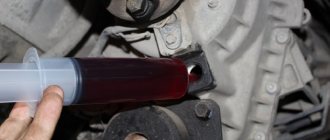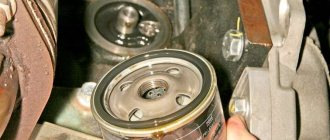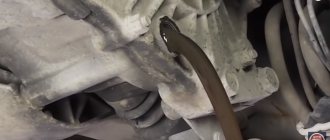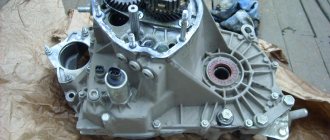The Chevrolet Lacetti manufacturer implies that replacing the transmission lubricant is necessary only in case of transmission repair. There is not even a drain hole in the pan. But the experience of car enthusiasts suggests that severe operating conditions, for example, driving on rough roads, traffic jams and low temperatures, quickly wear out the lubricant. As a result, the oil loses its protective properties, and the gearbox mechanism begins to collapse. This affects operation by poor gear shifting, knocking and noise from the gearbox.
Do-it-yourself recommendations for changing the oil in a Chevrolet Lacetti manual transmission.
Therefore, timely replacement of lubricant is a necessary measure in order to prevent malfunctions and extend the service life. An incorrectly performed procedure will result in damage to the transmission unit. Changing the oil in a Lacetti box can be done either at a service station or independently if you have a little skill.
Checking the oil level and condition
You need to check the oil level of the Chevrolet Lacetti manual transmission at every maintenance, as well as if there are signs of deterioration in performance. The check must be performed on a cold gearbox. To do this, place the car on an inspection hole, overpass or lift. The engine protection is removed. The inspection hole is located between the rear support of the power unit and the wheel drive on the right side. Use a 13 mm socket wrench to unscrew the plug and assess the fluid level in the transmission. It is considered sufficient to lower the level no more than four millimeters from the edge of the hole. If there is insufficient oil, you need to figure out the cause of the leak and add the required amount.
Recommended volumes and principle of lubricant selection
Chevrolet Lacetti cars are equipped with a 4-speed automatic transmission or 5-speed manual transmission. For each type of transmission, the manufacturer provides a specific brand and volume of oil to be filled.
| Element | Let's talk | Application | |
| Automatic transmission | 1.6D | 5.77±0.3 l | It is recommended to use fluids that meet the quality standards of JWS 3309, Esso ATF LT 71141 (yellow) or Total ATF H50235. |
| 1.8D | 6.9±0.3 l | ||
| Manual Transmission | 1.8±0.3 l | Semi-synthetic oils that meet the SAE 80W specification, for vehicles operating in extremely low temperatures - SAE 75W - 90. | |
The recommended oils shown in the table are typical of currently manufactured products. In the future, they may change in accordance with the requirements of the automaker.
Which oils are better to choose?
The decision to change the old fluid immediately can cause the problem of choosing a new one. The fact is that the manufacturer does not indicate what original oil is poured into the manual gearbox. What kind of oil should I use? Dealers' opinions on this matter vary. Most experts recommend using Ravenol 75W90 API Gl-4 liquid. If this type is not available, fill in analogues: GM 75W90, Castrol Syntrans 75W90. We use only synthetics in the mechanics for good transmission performance. In this case, the transmission oil will last for a longer period of operation.
Selecting transmission oil
Before replacing the oil product, you must read the manual for using the Chevrolet Lacetti. In this manual you can find information about transmission oils that can be used for manual or automatic transmissions.
If it is not possible to use oil in the Lacetti box as recommended, then you can find out which analogue is suitable - you just need to know the appropriate tolerance and look for it on other transmission fluids. When buying oil, it is better to consult with knowledgeable people if in doubt.
Ravenol 75w90 Getriebeoel TSG GL-4 1l - semi-synthetic gear oil for gearboxes
More often they use oil such as 75W90 RAVENOL TSG. This is a semi-synthetic product, used in cars that have a high load level. This oil has a fairly affordable price with good performance characteristics.
This type of oil liquid has many advantages:
- Protects against wear.
- Guarantees stable operation if there are heavy loads.
- It has optimal viscosity at temperatures higher than 40 degrees.
- Has high thermal stability.
- Has excellent shear resistance.
- The oil fluid remains in the same state under heavy loads.
- Oily liquid cools only at low temperatures.
- Has good compatibility with elastomers to prevent leakage.
- This oil contains chemicals that prevent the spread of corrosion and reduce friction.
- This oil is available to everyone.
Complete oil change
Before draining the used fluid into the Chevrolet Lacetti gearbox, the car should be warmed up to operating temperature. Changing the oil in the box with your own hands is done on an overpass, inspection pit or on a lift. The procedure differs from other brands in that the Lacetti does not have a drain hole. Changing the oil in a Chevrolet Lacetti manual transmission consists of the following steps:
- Place the car on the inspection hole.
- Find the breather under the hood and unscrew it. This is necessary for maximum oil flow.
- Under the car, find and unscrew the manual transmission inspection hole plug.
- Prepare a container for the waste liquid.
- Using a 13 mm spanner, loosen the pan mounting bolts.
- Use a screwdriver to pry the pan so that the lubricant begins to pour out.
- After draining, remove the pan with the remaining grease.
- Wait until the liquid is completely drained.
- Wipe and clean the pan and crankcase surface.
- Lubricate the adjacent surfaces of the sump and manual transmission housing with sealant.
- Install a new gasket.
- Carefully tighten the mounting bolts.
- Wait for the time indicated on the sealant package to cure.
- In the engine compartment, use a syringe to fill in new oil until it begins to pour out through the inspection hole.
- Replace the breather.
- Check the lubricant level again.
After a few days, check for possible leaks. Next, check the fluid level every fifteen thousand kilometers.
Why is low-quality gearbox oil harmful?
Before you do what you need to do, find out the risks of operating the mechanism on an unknown liquid.
Risks for classic cars on mechanics
Classic is good in terms of unpretentious maintenance and the requirement of moderate standards from transmission and motor fluids. The old mechanics forgive even the pouring of settled waste. However, over time, the deformation process still develops.
When using a low-quality fluid or a composition that is not comparable in terms of requirements and tolerances, gradual wear of the gearbox occurs, namely gear rims, satellites, and teeth. As a rule, this effect is felt after 2–3 thousand kilometers. The box begins to howl.
When driving a fake, the process is aggravated by unknown additives or lubricant base. The composition may foam and produce sediment in the form of solid flakes. Such a development of events will 100% ruin the mechanism, which will lead to a complete replacement of the structure.
Risks for cars equipped with automatic transmission
With machine guns things are much worse. Classic varieties in 4 - 5 gears can tolerate driving on second-rate lubricant. However, due to the complexity of the design, the mechanism will wear out faster.
Modern gearboxes designed for 7, 8 and 9 gears are a separate category that requires careful maintenance. There is also a critical need to comply with all manufacturer requirements.
The point is in the design of the block. New automatic transmissions consist of complex mechanisms created with a minimum margin of safety and clearances. The circuit contains slipping clutches and complex moving parts. Oils with insufficient protective film thickness or low resistance to mechanical destruction cannot neutralize the effects of increased friction. This causes scuffing and the formation of metal shavings.
Poor quality gearbox fluid may not guarantee sufficient viscosity and fluidity. The effectiveness of the package of main additives that make up the components is also questionable. A surrogate lubricant causes blockages in pressure lines, filters and the formation of sludge deposits on the walls of the housing.
Chevrolet Lacetti 1.6, 1.8, 2.0 automatic transmission oil, how much and what kind is required?
Chevrolet Lacetti is a compact C-class car, first introduced in 2002. The Lacetti family includes a sedan, and the hatchback and station wagon of the same name appeared a little later. The car was initially sold under the name Daewoo Lacetti, as well as the Chevrolet Nubira - in particular in Europe. However, since 2004, the European version has been renamed Chevrolet Lacetti.
In general, the car had many names depending on the market. For example, in China the model was called Buick Excelle, in Australia - Holden Viva, and in Canada and the USA - Chevrolet Optra and Suzuki Forenza, respectively. In 2006, production was organized in Russian Kaliningrad, and in 2008 the car began to be produced in Russia in a full cycle, including welding and body painting.
Modifications with gasoline engines of 1.4, 1.6 and 1.8 liters, with output of 95-122 liters, were supplied to the Russian market. With. In Europe, it was still possible to purchase a two-liter version with a power of 122 hp. s., which was not represented in Russia. For all markets, two types of gearboxes were offered - a five-speed manual and a four-speed automatic.
In the Korean market, the Chevrolet Lacetti was relevant until 2008 - in connection with the appearance of the Chevrolet Cruze as a successor to the Lacetti. In Russia, the car was relevant until 2012. This was due to the very high demand for the car, which in the Russian Federation was considered the best-selling C-class model. In the period 2004-2012, only 285 thousand Chevrolet Lacetti were sold.
Since 2008, the car is still produced in Uzbekistan. Today the model is known in Russia as Ravon Gentra.
How much oil is required for a Chevrolet Lacetti automatic transmission?
Let's consider the required oil volume in a Chevrolet Lacetti automatic transmission.
Generation 1 (2004-2013)
- Oil volume for automatic transmission with engine 1.6 16V 109 l. With. – 5.6-6.0 l.
- Oil volume for automatic transmission with engine 1.8 16V 122 l. With. – 5.6-6.0 l.
- Oil volume for automatic transmission with 2.0 TCDi engine is 121 l. With. – 7.1 l.
Which oil is suitable for Chevrolet Lacetti automatic transmission
Let's consider the optimal characteristics of transmission oil for Chevrolet Lacetti automatic transmission.
Other brands
The owner of a Chevrolet Cruze always has the right to choose - purchase an expensive original product, or buy something cheaper, but no worse than the original. There are many analogues on the market, the quality of which cannot be doubted. For example, among them it is worth highlighting such as Shell, Mobile, Castrol, Total, ZIK and Motul. The most important thing is to pay attention to viscosity parameters, tolerances and quality standards. The optimal parameters are indicated as API GL-4, SAE 75W-90/80W-90.
In first place in terms of wear resistance is Motul Gear 300 75W-90. Second place goes to Castrol Syntrans Transaxle 75W90, and third place to Mobil Mobilube 75W90.
All three oils work ideally in temperature ranges from – (minus) 35 to +35 degrees.
An alternative option is Lukoil TM-4 75W-90. This is a good semi-synthetic oil, inferior in parameters to most imported lubricants. And yet, this product is well adapted to low temperatures. This model has the lowest cost among foreign oils for Chevrolet Lacetti manual transmission.
Is it necessary to change the oil in the mechanic's box?
Any car owner knows that stable operation of components and mechanisms is possible only if you regularly change the oil in them. We are talking not only about the engine, but also about the gearbox. You can find a lot of information on the Internet about the frequency of changing the lubricant in automatic transmissions. The most optimal period is considered to be 50–60 thousand km. Not much is known about how often to change the fluid in manual transmissions. Not all owners of cars with a manual transmission understand the optimal period for changing the lubricant, at which the transmission would serve for a long time without forcing the driver to think about repairs. Many are completely convinced that this procedure is not necessary and are convinced that the “mechanics” will serve without repair for many years with oil once filled. Moreover, not all car owners have any idea what kind of composition is poured into the box. But the “mechanics” itself can remind you of the need for replacement, starting to emit a characteristic howl in the first two gears after 120–150 thousand km. This will mean it's time to change the lubricant.
In fact, the fluid is poured into the manual transmission for its entire service life, until the unit fails due to poor quality of the lubricant. In this case, it is necessary to understand the very concept of “service life”.
Today it is already common knowledge that almost all vehicles sold in Russia are developed in other countries. And there, on average, cars last less, and drivers change them more often, out of desire, and not out of necessity, when it is no longer possible to drive an old car. There are cases when used, but still usable cars with minor defects are sent to a landfill. The driver buys a new car, drives it for up to 5 years until the warranty expires, and exchanges it for the next car. Abroad, this period can be called service life.
In Russia the situation is different. Here, especially in the provinces, many cars made in the 1970s are still in use. The cars would not have lasted so long if the oil in their gearboxes had not been regularly changed, since spare parts for these outdated models have not been on sale for a long time.
Thus, if service life means a 5-year period with a mileage of 100 thousand km, then lubricant is actually poured into the “mechanics” for this entire period. In cases where the car is expected to be used for a much longer period of time, it is better to change the oil every 2–4 years or every 50 thousand km, depending on which limit comes first.
Which product is best for Lacetti
Two types of transmission fluids are very suitable for the Lacetti car due to the high quality and versatility of the material. Sold in liter jars.
Attention! For a complete replacement, you need to buy 9 liters of lubricant from the car owner. For partial - you need 4 liters.
The following types of high-quality oil are suitable for the automatic transmission of a Lacetti car:
- KIXX ATF Multi Plus;
- ENEOS ATF 3 DEXRON III MERCON ATF SP III;
- Mobile ATF LT 71141.
ENEOS ATF 3 DEXRON III MERCON ATF SP III
This high-quality multi-purpose lubricant has the following beneficial properties:
- has a good percentage of viscosity;
- frost-resistant below thirty degrees Celsius;
- prevents oxidation;
- has anti-foam properties;
- anti-friction.
It contains special components that have a beneficial effect on both the new Lacetti automatic transmission and the one that has already been repaired. Therefore, before changing this product in the Lacetti automatic transmission to some other cheaper one, it is worth taking a closer look at this type of fluid.
Mobil ATF LT 71141
However, if there is nothing else to replace a branded product other than Mobil ATF LT 71141, then you should listen to the advice of experienced car owners. Mobile is recommended.
Read Changing the oil in the automatic transmission of Peugeot 206
Mobil is designed for heavy duty vehicles. It can be used for a long time without replacement. And most likely, when a car owner buys a new car, he will find this exact oil in the automatic transmission. The additives that are added to this synthetic automatic transmission fluid will help the Lacetti car to last several tens of thousands of kilometers without complaints. But the car owner is simply obliged to monitor the level of the lubricant.
How often to change engine oil
First, let's ask ourselves the question - how often to change the oil? It is clear that the more often the better. But oil, especially good oil, is not cheap, and you need to allocate time, which is always in short supply.
There are car enthusiasts who change oil strictly at mileage intervals of 10,000 km, 7,000 km, and others even more often. And there are those who change strictly according to the season, for example, in the fall before winter or in the spring after winter.
A lot depends on the driving style and operating conditions. The oil should be changed more often if:
- frequent traffic jams
- low quality fuel, especially with high sulfur content
- operating a vehicle in dusty or polluted air conditions
- trailer towing
- Frequent traffic jams and start-stop mode
- regular trips over short distances, especially in winter, when the engine does not have time to reach the temperature properly
In general, it all depends on the operating conditions of your particular car, as well as on the quality of the oil you buy.
Personally, I used to change it every 10 thousand km. With the increase in mileage, I lowered the bar to 8 thousand km.
How much to fill
Let's pay attention to how much oil is required for a Chevrolet Lacetti manual transmission. The manufacturer recommends pouring exactly 1.8 liters of liquid. This volume is considered the maximum, but it is possible that in some cases it will be possible to pour in much less oil - for example, if the box is not sufficiently rinsed of old oil residues. To pour in the entire volume, you will need a complete replacement with flushing. It can also be done at home. After completing this procedure, be sure to use the dipstick and check the level.
View oil prices
Is it worth changing the oil in the Lacetti gearbox?
This question is the most important. The opinions of car owners are divided - some change the oil in the gearbox, others fundamentally do not do this. There is no definite answer here and there will not be, and everyone decides for themselves what to do with their car. I will just write my opinion, and the choice will be yours.
At this point in time, we have clear instructions from the manufacturer that oil is poured into the gearbox for the entire service life of the vehicle, and, accordingly, cannot be replaced. Which, by the way, is evidenced by the absence of a drain plug in the gearbox. The manufacturer also clearly explained that it is necessary to check the oil level every 15 thousand kilometers and, if necessary, top up. It is also said that if the gearbox is repaired, the oil must be changed. But, in turn, it is not specified what, in their opinion, “car service life” means.
According to unofficial data, the service life of a car in the West is approximately seven years (35 thousand kilometers per year). Then these cars end up with us and we are incredibly happy that we managed to buy an almost new car for pennies))) And this car will drive around our country for another twenty to thirty years! And only God knows what will happen to this oil.
The argument that lubricant production technologies have gone far ahead is somehow hard to believe when you take a can of oil and read that the shelf life is 5 years! And this is a shelf life, not a service life. Based on this fact, we can conclude that it is certainly advisable to change the oil without waiting for repairs.
Moreover, each oil has its own service life. For example, synthetic oil can last 120-150 thousand km, while it is advisable to change mineral oil after 50-60 thousand km. Semi-synthetic options are somewhere in the middle.
Therefore, any car owner who respects his car should change the gearbox oil regularly.
After the replacement, it immediately became noticeable that the box worked easier, especially in cold weather. But this largely happened not just from the replacement, but from the fact that I filled in oil with a different viscosity index.
Choosing oil for manual transmission on a Chevrolet Lacetti
Chevrolet Lacetti cars with a manual gearbox are filled with synthetic or semi-synthetic oil. Mineral based is practiced to a lesser extent. The manufacturer allows refueling with mineral oil only with significant mileage and preparation for major repairs; in all other cases, synthetics. Recommended: API GL-4, SAE 75W90, SAE 80W90.
When purchasing oil yourself, always follow the information in the instruction manual. If the transmission is replaced at a service station, always check the brand and type of oil with a mechanic. If necessary, adjust the actions, provide your own oil for filling.











